Chevrolet C/K
C/K is a series of trucks that were manufactured by General Motors. Marketed under the Chevrolet and GMC brands, the C/K series included a wide range of vehicles. While most commonly associated with pickup trucks, the model line also included chassis-cab trucks and medium-duty trucks and served as the basis for GM full-size SUVs. Used for both the model branding and the internal model code, "C" denoted two-wheel drive; "K" denoted four-wheel drive.
| Chevrolet and GMC C/K | |
|---|---|
.jpg.webp) 1986 GMC C/K Sierra Classic 3+3 | |
| Overview | |
| Manufacturer | General Motors |
| Also called | GMC C/K GMC Sierra |
| Production | 1959–2002 (United States) 1959–2000 (Canada) 1965-2002 (Mexico) 1964–2001 (Brazil) 1975–1982 (Chile) 1960–1978 (Argentina) 1986–1991 (Argentina by Sevel) |
| Body and chassis | |
| Class | Full-size pickup truck |
| Body style | 2-door regular cab 2-door extended cab 3-door extended cab 4-door crew cab |
| Layout | Front-engine, rear-wheel-drive layout, Front-engine, four-wheel-drive layout |
| Chronology | |
| Predecessor | Task Force |
| Successor | Chevrolet D-20 Chevrolet Silverado |
Introduced for the 1960 model year, four generations of the model line were produced, with GMC rebranding full-size pickups under a singular GMC Sierra nameplate for 1988. GM marketed the C/K in South America in Brazil, Chile, and Argentina.
After 1989, medium-duty trucks exited the C/K series, replaced by the Chevrolet Kodiak/GMC TopKick. For 1999, the Chevrolet Silverado (marketed by GMC as the Sierra) replaced the model line, with production of C/K pickup trucks ending after the 2000 model year. Drawing its nameplate from the top-level C/K trim, the Silverado consolidated Chevrolet pickup trucks under a singular nameplate (following GMC). The final C/K vehicles were heavy-duty chassis cabs sold through the 2002 model year.
First generation (1960–1966)
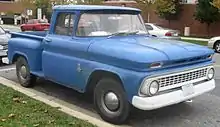
| First generation | |
|---|---|
_-_10275993623.jpg.webp) | |
| Overview | |
| Also called | Chevrolet: – C10/K10 – C20/K20 – C30 – C40 to C80 (medium- & heavy-duty models) GMC: – 1000/K1000 – 1500/K1500 – 2500 – 3000 to 6500 (medium- & heavy-duty models) Chevrolet Apache Chevrolet Viking Chevrolet Spartan |
| Production | September 1959–1966 |
| Assembly | Pontiac West Assembly, Pontiac, Michigan Dover, England Oshawa, Ontario Buenos Aires, Argentina |
| Designer | Harley Earl (1957, 1958)[1] |
| Body and chassis | |
| Related | Chevrolet Suburban |
| Powertrain | |
| Engine | 230 in3 (3.8 L) I6 236 in3 (3.9 L) I6 250 in3 (4.1 L) I6 261 in3 (4.3 L) I6 292 in3 (4.8 L) I6 305 in3 (5.0 L) V6 283 in3 (4.6 L) V8 327 in3 (5.3 L) V8 |
| Transmission | 3-speed synchromesh manual 4-speed synchromesh manual 2-speed Powerglide automatic[2] |
| Dimensions | |
| Wheelbase | 115 in (2,921 mm) (short box: ½-ton models)[2] 127 in (3,226 mm) (long box: ½-ton & ¾-ton models) 133 in (3,378 mm) (1-ton models) |
| Length | 186.875 in (4,747 mm) SWB[3] 206 in (5,232 mm) Standard[3] 216.25 in (5,493 mm) LWB[3] |
| Width | 78.75 in (2,000 mm)[3] |
| Height | 71.25 in (1,810 mm)[3] |
Launched in the fall of 1959, the 1960 model year introduced a new body style of light pick-up truck that featured many firsts. Most important of these were a drop-center ladder frame, allowing the cab to sit lower, and independent front suspension, giving an almost car-like ride in a truck. Also new for 1960 was a new designation system for trucks made by GM. Gone were the 3100, 3200, and 3600 designations for short 1/2, long 1/2 and 3/4-ton models. Instead, a new scheme assigned a 10, 20, or 30 for 1/2, 3/4, and 1-ton models. Since 1957, trucks were available from the factory as four-wheel drive, and the new class scheme would make this known. A C (conventional) in front of the series number designates 2-wheel rear drive while a K designates 4-wheel drive.
Actual badging on Chevrolet trucks carried the series name system from the previous generation for 1960 and 1961: the 10, 20, 30, and 40 series (C and K) were badged as "Apaches", 50 and 60 series trucks were badged as "Vikings", and the largest 70 and 80 series models were marked "Spartans". For 1960, C/K trucks were available in smooth "Fleetside" or fendered "Stepside" versions. GMC called these "Wide-Side" and "Fenderside". Half-ton models were the C10 and K10 long-bed and short-bed trucks, and The 3/4-ton C20 and K20, as well as the one-ton C30, were also available. GMC did not use the "C" nomenclature, though their 4x4 versions used the "K" nomenclature. GMC model numbers for 1/2, 3/4, 1, and 1.5 ton were 1000, 1500, 2500, and 3000. The 1.5 ton Chevrolet C40 and GMC 3000, which were using the light-duty cab[4][5] (but only as chassis-cab and stake models), were discontinued for the 1963 model year.[5][6]
The 1960, 1961, and 1962 models featured ball bearing front hubs,with torsion bar front suspensions, with trailing arm suspension rears. Trim lines were base and "Custom". Engines included the base GMC 305 in3 V6 for the GMC version, 135 hp (101 kW) 236 in3 (3.9 L) and 150 hp (112 kW) 261 in3 (4.3 L) straight-6s, and a 283 in3 (4.6 L) V8 with 185 hp (119 kW).
.jpg.webp) 1965 Chevrolet C-10
1965 Chevrolet C-10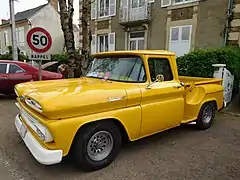 1961 Chevrolet Apache
1961 Chevrolet Apache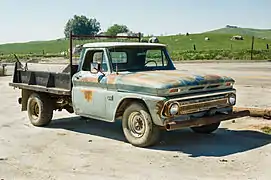 1966 Chevrolet C-30 dump truck in Porterville, California
1966 Chevrolet C-30 dump truck in Porterville, California.jpg.webp) Chevrolet C-10 Stepside
Chevrolet C-10 Stepside
A coil-spring front suspension came in 1963, with roller bearing front hubs, along with a new base engine, a 140 hp (104 kW) 230 in3 (3.8 L) I6, and an optional 165 hp (123 kW) 292 in3 (4.8 L) I6. The cab was modified for 1964, with elimination of the "wraparound" windshield and a new front grille design, along with various interior changes, while retaining the original design on the body. Air conditioning and a 220 hp (164 kW) 327 in3 (5.3 L) V8 came in 1965. A new base engine finished the model in 1966 with a 155 hp (116 kW) 250 in3 (4.1 L) I6.
Medium- & heavy-duty models
Medium-duty trucks were:
- 1½-ton Chevrolet C40 / GMC 3000 (1960–62), with the light-duty cab;
- Chevrolet C50 and C60;
- GMC 3500, 4000 and 5000.
Heavy-duty trucks were:
- Chevrolet C60-H[7] (a C60 with a heavier GVWR: 22,000 lbs instead of 19,500 lbs), C70 (1960–61) and C80;
- Chevrolet tandem rear axle models M60 (1963–66), M70 (1960–61) and M80 (1962–66);
- GMC 5500, 6000 and 6500;
- GMC tandem rear axle models W5000, W5500 and W6500.
.jpg.webp) 1960-61 GMC medium-duty truck
1960-61 GMC medium-duty truck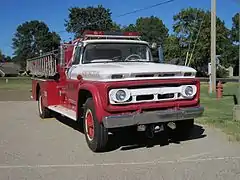 1963 Chevrolet medium-/heavy-duty truck
1963 Chevrolet medium-/heavy-duty truck.JPG.webp) 1966 GMC medium-duty truck
1966 GMC medium-duty truck.jpg.webp) 1966 Chevrolet C60
1966 Chevrolet C60
Second generation (1967–1972)
| Second generation | |
|---|---|
 Chevrolet C-10 stepside | |
| Overview | |
| Model years | 1967–1972 |
| Assembly | Atlanta, Georgia Baltimore, Maryland Pontiac, Michigan Flint, Michigan Tarrytown, New York Kansas City, Missouri St. Louis, Missouri Janesville, Wisconsin Norwood, Ohio Fremont, California Oshawa Buenos Aires, Argentina Dover, England |
| Body and chassis | |
| Related | Chevrolet Silverado Chevrolet K5 Blazer Chevrolet Suburban |
| Powertrain | |
| Engine | 250 cu in (4.1 L) I6 292 cu in (4.8 L) I6 283 cu in (4.6 L) V8 305 cu in (5.0 L) V6 307 cu in (5.0 L) V8 327 cu in (5.4 L) V8 350 cu in (5.7 L) V8 351 cu in (5.8 L) V6 366 cu in (6.0 L) V8 402 cu in (6.6 L) V8 |
| Transmission | 3-speed manual 4-speed Muncie SM420 manual 4-speed Muncie SM465 manual 4-speed New Process NP435 manual 2-speed Powerglide automatic 3-speed THM-350 automatic 3-speed THM-400 automatic |
| Dimensions | |
| Wheelbase | 115 in (2,921 mm) (short box) 127 in (3,226 mm) (long box) 133 in (3,378 mm) (Longhorn) |
| Length | 188.5 in (4,788 mm) (short box) 207.75 in (5,277 mm) (long box) 213.75 in (5,429 mm) (Longhorn Fleetside) 217.75 in (5,531 mm) (Longhorn Stepside) |
A new, more modern look came for 1967, along with a new nickname: "Action Line". It was with this revision of the C/K truck that General Motors began to add comfort and convenience items to a vehicle line that had previously been for work purposes alone. The majority of 10 series and some 20 series Chevrolet trucks from 1966 to 1972 were equipped with a coil spring trailing arm rear suspension, which greatly improved the ride over traditional leaf springs. However, the leaf spring rear suspension was still available on those trucks, and standard on 30 series trucks. GMC-branded trucks came standard with leaf springs in the rear, with the coil spring/trailing arm design optional. All 2-wheel drive trucks came with independent front suspension, while 4x4's used a conventional solid axle with leaf springs. 1967 was the only model year for the "small rear window" (RPO A10 offered a large rear window as a factory option[8]). The standard drivetrain was a three-speed manual transmission and one of two engines; the 250 in3 straight six or the 283 cu in (4.6 L) V8. Optional transmissions included a three speed overdrive unit (C-10 only) and several different four-speed manuals, the Powerglide 2-speed automatic, or the Turbo-Hydramatic 350 and 400 3-speed automatic.The 292 six and the 327 in3 V8 were optional engines. 10-series trucks came with a 6 x 5.5–inch bolt pattern, the 3/4 and 1 ton trucks came with an 8 x 6.5–inch bolt pattern.
The most visible change in differentiating a 1968 from 1967 models was the addition of side-marker reflectors on all fenders. Also, the small rear window cab was no longer available (the C40 and C60 medium duty trucks retained the small window). The GMC grille was revised, with the letters "GMC" no longer embossed in the horizontal crossbar. Another addition was the Custom Comfort and Convenience interior package that fell between the Standard cab and CST cab options. In 1968, Chevrolet celebrated 50 years of manufacturing trucks, and to commemorate, they released a 50th Anniversary package featuring an exclusive white-gold-white paint scheme. Also in 1968, the 307 and 396 CID V8's were added as well as the Longhorn model on 3/4 ton trucks. Featuring a 133-inch wheelbase, the Longhorn added an extra 6 inches (15 cm) to the bed. Longhorns were only two-wheel-drive; no factory Longhorn 4x4 was built.
.jpg.webp) 1967 GMC C/K
1967 GMC C/K.jpg.webp) 1968 GMC C/K
1968 GMC C/K.jpg.webp) 1970 GMC C/K
1970 GMC C/K
The 327 c.i. V-8 engine (220-240 gross HP in '67-8) was dropped in 1969 in favor of the 350 CID variant rated at 255 gross HP (200 net H.P. or 195 net H.P. with "A.I.R." smog equipment). Along with the new engines came a new grille design for Chevrolet trucks and a more upright hood for both Chevrolet and GMC trucks. A utility variant, known as the K5 Blazer, was also introduced with a shorter wheelbase of 104 inches (2,642 mm). The GMC version, known as the Jimmy, was introduced the same year. Some internal cab changes were also made, most notably the switch from a hand-operated parking brake to a foot pedal, and a more modern looking two-spoke steering wheel with plastic horn button replaced the previous year's three-spoke wheel with chrome horn button. Also new this year were upper and lower side moldings, which added another two-tone paint option. These were standard on CST trucks, and optional in any other trim level. The Sierra and Sierra Grande option packages were also added for GMCs; these were to become discrete trim levels in 1972.
The only noticeable change for 1970 was a minor update to the Chevrolet grille. At first glance, the 1969 and 1970 grilles look very similar. However, the 1970s plastic inserts actually have highlights that divide the appearance into six separate sections. The 396, while still sold as such, was enlarged to 402 cubic inches starting in 1970.
 1970 Chevrolet C-10 with the Custom trim level
1970 Chevrolet C-10 with the Custom trim level 1970 GMC C2500 Sierra Grande
1970 GMC C2500 Sierra Grande
Numerous changes occurred in 1971. First came another new grille design (the "egg crate") for Chevrolet trucks and black paint over portions of the GMC grille. Second, an additional trim package was introduced: the Cheyenne. On GMC models, this was equivalent to the Sierra. These packages consisted mostly of comfort features — nicer interiors, more padding and insulation, carpet, chrome trim, and upper and lower side molding and tailgate trim. 1971 was the first year for AM/FM radios factory installed. Finally, the front brakes on all light-duty trucks were switched from drum brakes to disc brakes, resulting in much less brake fade under heavy use. While prior C/K half-ton trucks had used a six-lug bolt pattern (6 x 5.5") for the wheels, two-wheel-drive models switched to a five-lug pattern (5 x 5–inch bolt circle) common to Buick, Oldsmobile, Pontiac, and Cadillac passenger cars. The 1/2 ton 4 x 4 retained the 6 lug bolt pattern. This bolt pattern would remain the standard through the end of the C/K series (along with the Chevrolet/GMC vans). The 20 and 30-series trucks had the 8 x 6.5" pattern. Also, Chevrolet changed the 396 V8 emblem designation to 400 V8.
The 1972 models were very similar to the 1971 models, with the only change being the rear view mirror was glued to the windshield rather than bolted to top of the cab, and metal or vinyl-covered flat door panels were no longer available; all trim level door panels were molded plastic with integral armrests and wood grain inserts on Cheyenne and Sierra trim levels. For restoration, it should also be noted that the door and window cranks were slightly longer due to the molded plastic door panels, and the vent windows were now secured with a single screw on the inside of the door, thus differentiating it from the 1971 model year. The trim levels were rearranged on GMCs, with the Custom now being the lowest level (the Deluxe being dropped) and the Sierra and Sierra Grande becoming separate trim levels at the top of the lineup rather than option packages as before.
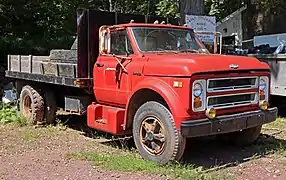 1971 Chevrolet C-50 medium-duty truck
1971 Chevrolet C-50 medium-duty truck 1971 Chevrolet C-20 Custom
1971 Chevrolet C-20 Custom.JPG.webp) 71-72 Chevrolet C-10 Cheyenne
71-72 Chevrolet C-10 Cheyenne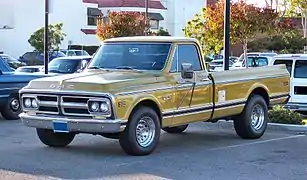 1972 GMC C-Series with the Sierra trim level
1972 GMC C-Series with the Sierra trim level
Engines
| Year | 1967 | 1968 | 1969 | 1970 | 1971 | 1972 |
|---|---|---|---|---|---|---|
| Inline 6 | 250 in3 292 in3 |
250 in3 292 in3 |
250 in3 292 in3 |
250 in3 292 in3 |
250 in3 292 in3 |
250 in3 292 in3 |
| V6 (GMC) | 305 in3 351 in3 |
305 in3 351 in3 |
305 in3 351 in3 |
|||
| V8 | 283 in3 327 in3 |
307 in3 327 in3 396 in3 |
307 in3 350 in3 396 in3 |
307 in3 350 in3 396 in3 |
307 in3 350 in3 402 in3 |
307 in3 350 in3 402 in3 |
Trim Levels (Chevrolet)
| Years | Base | Mid-level | High-level | Top-line |
|---|---|---|---|---|
| 1967–70[9][10] | Standard | Custom | -- | CST (Custom Sport Truck) |
| 1971[11] | Custom | Custom Deluxe | -- | Cheyenne |
| late 1971–72[12] | Custom | Custom Deluxe | Cheyenne | Cheyenne Super |
A 10, 20, or 30 on the emblem indicates 1⁄2-, 3⁄4-, or 1-ton trucks. There are also 40- to 80-series medium- and heavy-duty trucks:
- medium-duty
- 1 1⁄2-ton C40;
- "light" 2-ton C50;
- 2-ton C60;
- heavy-duty
- "light" 2 1⁄2-ton C70;
- 2 1⁄2-ton C80.[13]
These models share the cabin of the light-duty models but sit on a taller chassis and have a taller front end of a different design, with a clamshell hood.
Trim Levels (GMC)
| Years | Base | Mid-level | High-level | Top-line |
|---|---|---|---|---|
| 1967–71[14] | Deluxe | Custom | -- | Super Custom |
| 1972[14] | Custom | Super Custom | Sierra | Sierra Grande |
1500, 2500, and 3500 designations were used to indicate 1⁄2-, 3⁄4- and 1-ton trucks. Sierra and Sierra Grande had been used as names on option packages since the 1969 model year.
In both series, the 'Highlander package' included special color-coordinated houndstooth cloth inserts and additional trim colors and insulation.
Third generation (1973–1991)
| Third generation (Rounded Line) | |
|---|---|
.jpg.webp) | |
| Overview | |
| Also called | Chevrolet/GMC R/V series |
| Model years | 1973-1991 |
| Body and chassis | |
| Platform | GM C/K (Rounded Line) |
| Related | Chevrolet K5 Blazer/GMC Jimmy Chevrolet/GMC Suburban |
The third-generation C/K was introduced for the 1973 model year. Designated the "Rounded Line" generation by General Motors, the C/K grew in size inside and out. As pickup trucks increased in use as personal vehicles, cab features and options moved closer in line with GM sedans (with power windows and power door locks becoming options). To further expand its practicality, a four-door crew cab body was introduced (offering 6-passenger seating).
While relatively straight-lined and boxy in appearance (leading to their "Square-body" nickname from the public[15]) the Rounded Line trucks were the first generation of the C/K to be designed with the use of computers and wind tunnels, optimizing the exterior shape for lower drag and improved fuel economy. The chassis was an all-new design (with all trucks receiving a leaf-spring rear suspension); K-Series trucks moved to all-wheel drive (shift-on-the-fly 4x4 was introduced for 1981).
Alongside the introduction of the four-door crew cab, the third generation C/K marked the introduction of a dual rear-wheel pickup truck ("Big Dooley"). For 1978, the C/K became the first American full-size pickup truck sold with a diesel engine (a 5.7L Oldsmobile diesel V8); a 6.2L V8 diesel was introduced for 1982. This generation also marks the first use of the Chevrolet Silverado nameplate (in use for Chevrolet full-size trucks today).
The Rounded Line generation is the longest-produced version of the C/K model line, produced for 18 model years. For 1987, it was renamed the R/V series (to accommodate the fourth-generation C/K marketed alongside it) and was gradually phased out through the 1991 model year.
Fourth generation (1988–2000)
| Fourth generation (GMT400) | |
|---|---|
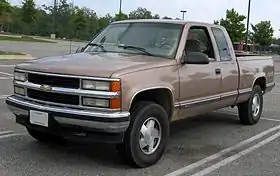 | |
| Overview | |
| Model years | 1988-2000 |
| Body and chassis | |
| Platform | GM GMT400 platform |
| Related | Chevrolet/GMC Suburban Chevrolet K5 Blazer/Chevrolet Tahoe/GMC Yukon/Cadillac Escalade |
The fourth-generation C/K was introduced in April 1987 for the 1988 model year. The first line not assigned a generational moniker by General Motors, it is known by its GMT400 internal codename. Slightly smaller in cab dimensions than the Rounded Line generation, the fourth-generation C/K increased interior space over its predecessor. After trailing Ford and Dodge by over a decade, GM introduced the C/K in an extended-cab configuration. For nearly five years, the fourth-generation C/K was sold alongside its R/V series predecessor, as the crew cab pickup (which served as the basis of the Suburban SUV) was not released until the 1992 model year.
In a branding change, the C/K nomenclature became exclusive to Chevrolet, as all GMC pickups became Sierras (GMC retained the C/K nomenclature for its internal model codes). Chevrolet introduced several specialized variants of the C/K series, including the work-oriented W/T 1500, off-road Z71, and the high-performance 454SS. Between one-ton trucks and medium-duty trucks, Chevrolet and GMC offered the C3500HD chassis cab for commercial use.
For 1995, the fourth-generation C/K underwent a mid-cycle revision, adding a driver-side airbag (dual airbags became standard for 1998). For 1996, the extended cab was redesigned, adding a rear-hinged passenger-side third door.
For the 1999 model year, to accommodate the introduction of the GMT800-chassis Chevrolet Silverado/GMC Sierra, the fourth-generation C/K was renamed as the Chevrolet Silverado Classic and GMC Sierra Classic. After the 2000 model year, C/K pickup trucks were discontinued. GM produced the heavy-duty C3500HD chassis cab as the final version of the C/K model family through the 2002 model year.
Brazilian versions
General Motors Brazil produced three generations of light trucks; while unique to the market, each version was also derived in part from a version of an American C/K truck family.
1964-1984
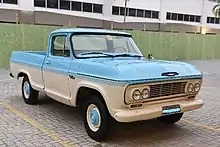

In 1964, GM Brazil launched its first line of light trucks designed in Brazil, the Chevrolet C-series pickup truck; in line with the Chevrolet Suburban, the model line was sold in a wagon configuration, renamed from C-1416 to Chevrolet Veraneio in 1969.[16] Styled with an exterior exclusive to Brazil, the model line shared its instrument panel with the first-generation Chevrolet C/K of 1960-1966. Nearly a decade before its American counterpart, a four-door "double cab" was offered alongside the standard two-door configuration, sharing its doors with the Veraneio wagon/SUV.
The model line was launched with a 261 cubic-inch inline-6 (derived from the Chevrolet "Stovebolt" engine); this engine was replaced in 1971 by a 250 cubic-inch inline-6 from the Chevrolet Opala.[16] In 1976, the standard gasoline engine for the C-10 became a 2.5L inline-4.[16] The first diesel-powered Chevrolet in Brazil, the D-series pickup introduced a Perkins 5.6L inline-6 diesel in 1965; a four-cylinder diesel was introduced in (Perkins Q20B) was introduced for 1978.[16] From 1977 to 1980, the Detroit Diesel 4-53 two-cycle inline-4 diesel was also offered as an option.[16] For 1981, the engine line was reduced to two, with a 4.8L inline-6 becoming offered in gasoline and ethanol-fuel versions (C-10 and A-10); the sole diesel was now a 5.8L Perkins inline-6.[16]
1985-1996
.jpg.webp)

For 1985 production, GM Brazil introduced a redesigned model line of light trucks. Sharing its cab structure with the "Rounded Line" generation, the 20-series received its own front fascia (sharing headlights with the Opala) and larger taillamps than its American counterpart. Far more advanced in design than its utilitarian predecessor, the 20-series carried over little more than its powertrains from the previous generation.[17][18] In addition to 20-series pickup trucks, GM Brazil offered a full line of Chevrolet medium and heavy-duty trucks derived from the "Rounded Line" cab.[16]
Again offered in single and double cabs (introduced in 1986), the C-20 and A-20 (ethanol) received a 4.1L inline-six, with the D-20 receiving the Perkins Q20B inline-4 diesel (replaced by the Maxion S4 for 1990[19]). In contrast to its American counterpart, the 20-series was offered nearly exclusively with 2-wheel drive; a 4x4 version was offered for 1989 and was withdrawn before the end of the model year, following poor reliability of its drivetrain.[20]
For 1988, the Veraneio wagon/SUV was redesigned for the first time since its introduction, adopting the 20-series body structure; the four-door was joined by the two-door Chevrolet Bonanza. With the exception of its taillamps and front fascia, the Veraneio adopted an appearance close to the Chevrolet/GMC Suburban; the Bonanza was proportioned similar to the Chevrolet K5 Blazer (though fitted with two-wheel drive and a permanent roof).[21]
For 1992, the 20-series underwent a minor exterior revision, again sharing its headlights with the Opala (higher-trim vehicles shared wheels with GMT400 pickup trucks); the interior underwent a redesign, adopting a redesigned instrument panel.[22]
For 1996, the model line adopted the fuel-injected 4.1L six from the Chevrolet Omega, ending its use of carbureted engines.[23]
1997-2001
.jpg.webp)
For 1997, the 20-series (based on the 1973 "Rounded Line" pickups) was retired, with GM Brazil introducing the Argentine-produced Chevrolet Silverado. In contrast to the previous two generations of Brazilian Chevrolet trucks, the Chevrolet Silverado was no longer a market-exclusive design; the Silverado was identical to the American-market GMT400 pickup. Offered only as a two-door C2500 with a standard-length bed, the Silverado offered a 138 hp 4.1L inline-6 (from the previous C-20/A-20 and the Chevrolet Omega) and a MWM-produced 168 hp 4.2L turbodiesel inline-6.[16] The locally-designed Veraneio and Bonanza were discontinued, with the full-size SUV role taken over in 1998 by production of the Chevrolet Tahoe (renamed as the Chevrolet Grand Blazer).
For 2000 production, production of the Silverado shifted from Argentina to Brazil.[16][23] Alongside the withdrawal of the Grand Blazer (in favor of the smaller Blazer derived from the S-10), the Silverado adopted a D-20 suffix (from the popularity of its predecessor[23]). During 2001, Chevrolet withdrew the 4.1L gasoline six from the Silverado D-20 (the final vehicle to use the engine).
The final Silverado D-20 was produced in January 2002. After many years of declining market share in the truck segment, GM Brazil shifted its production from heavy trucks towards the S-10 and car-based pickups.[16]
See also
- Chevrolet Silverado / GMC Sierra
References
- http://67-72chevytrucks.com/vboard/showthread.php?t=717697
- "Directory Index: GM Trucks and Vans/1960_Trucks_and_Vans/1960_Chevrolet_Truck_Foldout". Oldcarbrochures.com. Retrieved 2011-11-20.
- "Chevrolet C/K series Pick-Up (1961)". BWA. Retrieved 2013-10-29.
- "1961 Chevrolet Pickups, Chassis-cabs and Stakes brochure". oldcarbrochures.org. Archived from the original on 20 October 2016. Retrieved 21 August 2016.
- "GMC 3000 Model Series Trucks". 6066gmcguy.com. Retrieved 21 August 2016.
- "Chevrolet Trucks for 1963". oldcarbrochures.org. Archived from the original on 20 October 2016. Retrieved 21 August 2016.
- "1960 Conventional & LCF models - Competitive comparisons". oldcarbrochures.org. Archived from the original on 20 October 2016. Retrieved 21 August 2016.
- Chevrolet Trucks 1967 Optional Equipment list, issued by GM Heritage Center
- "1967 Chevrolet Pickups Brochure". Old Car Manual Project. Archived from the original on 6 March 2015. Retrieved 26 July 2015.
- "1970 Chevrolet Pickups Brochure". Old Car Manual Project. Archived from the original on 22 March 2016. Retrieved 26 July 2015.
- "1971 Chevrolet Pickups Brochure". Old Car Manual Project. Archived from the original on 20 October 2016. Retrieved 26 July 2015.
- "1972 Chevrolet Pickups Brochure". Old Car Manual Project. Archived from the original on 4 March 2016. Retrieved 26 July 2015.
- "1966 - 1968 Chevrolet medium & heavy duty conventional cab trucks". Classic Automobile Appraisal And Resource Guide. Retrieved 26 July 2015.
- See the excerpts of brochures shown in "GMC Trim Levels Q?". The 1947 - Present Chevrolet & GMC Truck Message Board Network. Retrieved 26 July 2015.
- Brownell, Tom "Rounded-Line Models, 1973–1987" Chevrolet Pickup Color History (Truck Color History) Chapter 9, pp. 88–89 1994-08-07 Retrieved 2011-01-15
- "Chevrolet: Moderno design brasileiro para a linha 64" [Modern Brazilian design for the 1964 cars line]. lexicarbrasil.com.br (in Portuguese). Retrieved 30 November 2014.
- "Google Translate". translate.google.com. Retrieved 2021-01-17.
- "Google Translate". translate.google.com. Retrieved 2021-01-17.
- "Google Translate". translate.google.com. Retrieved 2021-01-18.
- "Google Translate". translate.google.com. Retrieved 2021-01-18.
- "What was the Chevrolet Bonanza?". The Daily Drive | Consumer Guide®. 2018-05-14. Retrieved 2021-01-18.
- "Google Translate". translate.google.com. Retrieved 2021-01-18.
- "Google Translate". translate.google.com. Retrieved 2021-01-18.
